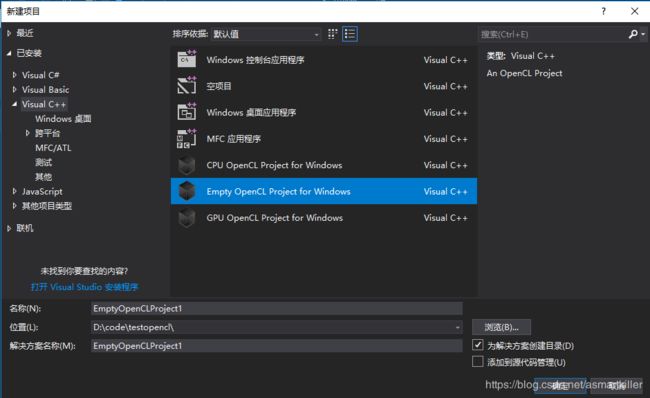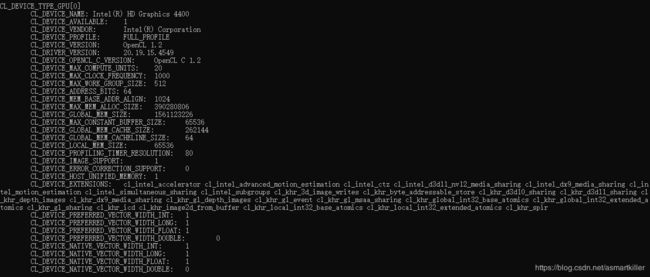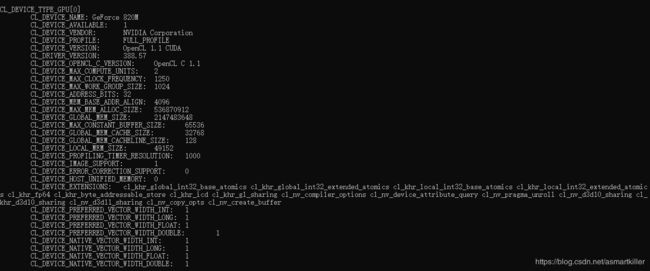OpenCL入门一:Intel核心显卡OpenCL环境搭建
本文在Windows 10 64位系统上搭建OpenCL开发环境,笔记本显卡的类型(使用英特尔® 驱动程序和支持助理查询):
| NVIDIA GeForce 820M | Intel® HD Graphics Family | |
|---|---|---|
| Adapter Compatibility | NVIDIA | Intel Corporation |
| Video Processor | GeForce 820M | Intel® HD Graphics Family |
| Driver Provider | NVIDIA | Intel Corporation |
| Driver Version | 23.21.13.8857 | 20.19.15.4549 |
| Driver Date | 2017/12/4 | 2016/11/10 |
| Adapter DAC Type | Integrated RAMDAC | Internal |
| Adapter RAM | 2.00 GB | 1.00 GB |
| Availability | Offline | Running at full power |
| Location | PCI bus 4, device 0, function 0 | PCI bus 0, device 2, function 0 |
| Device Id | PCI\VEN_10DE&DEV_1140&SUBSYS_228A1043&REV_A1\4&3A7A1238&0&00E4 | PCI\VEN_8086&DEV_0A16&SUBSYS_228A1043&REV_09\3&11583659&0&10 |
以及Intel® HD Graphics Family的一些参数Resolution:1366 x 768, Bits Per Pixel:32,Number of Colors:4294967296,Refresh Rate - Current、 Refresh Rate - Maximum、Refresh Rate - Minimum:60 Hz。
准备工作
Windows 驱动中自动包含了OpenCL驱动,VS2012-VS2017任意版本(这里使用的是VS2017)。下载Intel SDK for OpenCL applications,注意选择Windows平台,然后注册帐号后即可下载。下载测试程序,解压后打开CapsBasic目录下的sln文件(高版本自动升级项目)。

测试
新建项目

添加一个新文件HelloOpenCL.cpp,在文件中添加如下代码:
#include API函数clGetPlatformIDs()用来获取指定系统上可用的计算平台:
cl_int clGetPlatformIDs(cl_uint num_entries, cl_platform_id *platforms, cl_uint *num_platforms)
该函数通常由应用程序调用两次。首次调用时,将cl_uint指针和NULL传递给num_platforms和platforms参数。num_platforms即为可用平台的数量。第二次调用,将num_entries平台分配足够空间夫人地址传递给函数的cl_platform_id指针。
clGetPlatformInfo
API函数clGetDeviceIDs()获取指定平台上设备的数量。
cl_int clGetDeviceIDs(cl_platorm_id platform, cl_device_type device_type, cl_device_id *devices, cl_uint *num_devices)
从示例代码中看出cl_device_type的类型有:CL_DEVICE_TYPE_CPU、CL_DEVICE_TYPE_GPU、CL_DEVICE_TYPE_ACCELERATOR。
三个平台:NVIDIA CUDA、Intel® OpenCL、Experimental OpenCL 2.1 CPU Only Platform
对于Intel® OpenCL的详细设备情况:有一个CPU和一个GPU。


对于NVIDIA CUDA的详细设备情况:一个GPU。

对于Experimental OpenCL 2.1 CPU Only Platform的详细设备情况:只有一个CPU

对测试工程的分析
错误处理:
#define CAPSBASIC_CHECK_ERRORS(ERR) \
if(ERR != CL_SUCCESS) \
{ \
cerr \
<< "OpenCL error with code " << ERR \
<< " happened in file " << __FILE__ \
<< " at line " << __LINE__ \
<< ". Exiting...\n"; \
exit(1); \
}
通过宏定义对错误代码,文件和行数进行输出,并退出。
#define OCLBASIC_PRINT_TEXT_PROPERTY(NAME) \
{ \
/* When we query for string properties, first we */ \
/* need to get string length: */ \
size_t property_length = 0; \
err = clGetDeviceInfo( \
device, \
NAME, \
0, \
0, \
&property_length \
); \
CAPSBASIC_CHECK_ERRORS(err); \
/* Then allocate buffer. No need to add 1 symbol */ \
/* to store terminating zero; OpenCL takes care */ \
/* about it: */ \
char* property_value = new char[property_length]; \
err = clGetDeviceInfo( \
device, \
NAME, \
property_length, \
property_value, \
0 \
); \
CAPSBASIC_CHECK_ERRORS(err); \
cout \
<< " " << #NAME << ": " \
<< property_value << endl; \
delete [] property_value; \
}
使用宏函数:
- 针对宏定义中换行,换行符\必不可少(换行符加回车键)。针对执行语句的换行,我们同样可以使用\作为换行符,同时当一个语句过长时,直接换行,也并不会影响语句的编译。
- #NAME

这里的#NAME是使用NAME宏参数的字符串值来取代,从而打印出参数。由上图的示例可以看出。 - 在上面的测试代码中,将该段宏定义写在了主函数前面,有在main函数定义的err,并不是全局变量,但是并没有报错。说明编译器并不对宏定义进行语法检查。
#define OCLBASIC_PRINT_NUMERIC_PROPERTY(NAME, TYPE) \
{ \
TYPE property_value; \
size_t property_length = 0; \
err = clGetDeviceInfo( \
device, \
NAME, \
sizeof(property_value), \
&property_value, \
&property_length \
); \
assert(property_length == sizeof(property_value)); \
CAPSBASIC_CHECK_ERRORS(err); \
cout \
<< " " << #NAME << ": " \
<< property_value << endl; \
}
这里输入的TYPE是变量的类型,用于在宏定义代码中申明代码。


